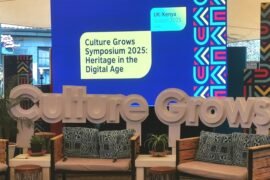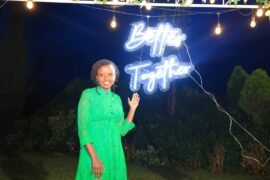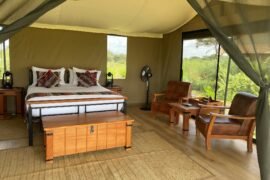The Marsabit Lake Turkana Festival is one of those “must attend” festivals in Kenya. The festival has been held annually in Loiyangalani since 2008 and it brings together the 14 communities found within the county who are dominantly pastoral and have preserved their culture. You will interact with communities like the Turkana, Samburu , Borana, Gabbra , Rendile , El Molo , Somali, Burji ,Konso, Sakuye ,Waata, Garee, Wayu, and Dassanatch, the last 5 I learnt of their existence at the festival.These communities are stereotyped to be enemies due to the many incidences of banditry in the region, but here , they were all, eating , drinking, singing and dancing together.

The air in Loiyangalani was charged, super charged. The excitement of the people was almost tangible and equally contagious. The locals were expectant of the “fruits” the festival would bring the town whilst I was expectant of what I would see, experience, learn, adopt and basically integrate into my life and not forgetting the pictures I would get. I will breakdown the festival into the below clusters so as to make you experience the actual festival through my eyes/words and hopefully entice you to attend the next one.
Homesteads
The pastoral communities though similar in several ways , differ in the way they make their homes. The constant similarity is that the homes usually referred to as manyattas are built by the women, yes from scratch. They vary in outlook from the shape, size and building elements.The most common building elements are twigs, wood, cow dung , reeds and soil. I will forever be grateful to Malabo Resort for making a long term dream of mine-to sleep in a Manyatta, come true.


Jewellery
I cannot get enough of this. Every time I see them, young, old, male, female I stare-I’m sorry. Beads are the dominant element used and the colours are bright to appeal to the eye like yellow, red, green, white, blue among others. The shapes of the beads also vary and they allow their artistic selves free range. As for the head, neck and shoulder pieces, beautiful doesn’t even start to describe them.

They are layered from the largest, which lies on /over the shoulders to neck pieces that at times ride high on the neck. These are worn on a daily basis, no need to wait for a special occasion as every day is a special occasion. Different communities have different colours and being “custom made”, each is different. Some have metal in them to make them shiny, others buttons-never thought buttons could look so good and others are dyed to give them a glossy shimmery look.

It is hypnotic to see how these master pieces sway as they move and when they dance. The same is exhibited in their bracelets, anklets, arm bands, earrings and headpieces -my new fashion fad

Adornment isn’t only for the women as the men also take body art and jewellery very seriously. The men wear traditional head caps as well as jewellery across their chests, arms and necks.

Body Art:
In some of the communities, the women adorn their hair and upper body with red ochre made from the bark of a plant mixed with cooking oil. The end result is a beauty to behold as the red stands out, it shimmers and I couldn’t be left behind from experiencing the same. Don’t I just look more beautiful?

I managed to fulfill another lifelong dream of mine, so ignore the rumors that the red is blood mixed with cowdung -who comes up with these things. I almost didn’t want to wash it off but a girl has got to bathe right?
Dressing:
I was awe struck, I was amazed, I was confused, I wanted all they were wearing. The clothes worn here were the traditional kind, not the modified modern/ traditional version. I spoke to the ladies on how some made their clothes and all I can say is, designers do not only exist in fashion houses in Europe or major towns.

The ladies shared how their dresses are made from goat hide and you will find varying colours black, brown among others. It takes several months to complete one dress as they are custom made. Also, they have to wait for a long duration to get enough goat hide material to complete a dress.They carefully scrape off the hair from the hide (fabric) , they then apply oil often to it to keep it supple and soft and then the dress making begins.

It is a taxing job both physically and mentally, but the final look which is beautiful dresses, beautiful pieces of art and the women looking even more beautiful, well worth it. When I asked whether the outfits are comfortable, the unanimous response was No. The outfits are heavy and get really hot. However, a lady has got to do what a lady has got to do to look fabulous, right? Others had their outfits made of shukas/ shawls in various colours from white to mixed colours.


It was interesting to actually watch a gentleman who makes these shawls with a traditional foot treadle floor loom at work. He would pass a spindle with thread from one end to the other, use an instrument that looked like a piece of wood to tighten the thread and repeat over and over again as his foot also worked simultaneously. It is a taxing job but the final products are master pieces, so the next time you try to bargain for the price, know it is a taxing endevour.

Entertainment:
Marsabit communities took entertainment to new heights. The local men and the ladies were dressed to a tee while we tourists/travelers seemed like lost people, that I have started my small pastoralist wardrobe collection. I previously perceived these communities to be closed and conservative, but my stereotype was shattered. I watched Borana /Gabra /Somali and other communities, women decked in brightly coloured clothes/ shukas/ deiras that were free flowing. Their dances mainly involved clapping hands, stomping feet and some very serious shoulder movement.

Moving onto the Samburu/Dashnash /Turkana /there is lots of jumping involved for the men, where it seems like they are competing who can reach the skies. The women mainly dance with their shoulders and necks allowing the neck/shoulder pieces to sway. I tried it as it seemed easy, but I assure you, it is an art you develop.
Then I watched other men groups I think they were Gabbra or Somali, dressed in white while, others in colored shukas/ shawls) seriously dancing, clapping hands, stomping feet and forming semi-circles. The men all flowed in unison to the beat of the drum and to the women singing. They moved forward then backward, on and on and I was transfixed.
Afterparty:
In the evening, we had serious after parties and lets just say, I learnt even more local music and dances. In one, we the ladies would sway on one spot, while holding to the ends of our dresses. When the music was at fever pitch, we would form a circle and sway/sashay going round and round. This was done only by the women as the men cheered us on from the sidelines.Then music would change and soon we would all be jumping up and down, others holding hands, others holding each other’s shoulders and we would get lost in the music. Most of the music was live performances by famous musicians like Lemarte among others


And to top it off, we had “ A Fashion show in the ” wild/dark.” Now, this tops any fashion show I have watched whether from Kenyan runways or the larger runways in Milan, NewYork, and Paris etc. The ladies and gentlemen put out an amazing show that showcased both their culture as well as their modelling skills. Local and international designers, welcome to Kenya , you can learn lots in regard to fashion, culture and diversity.
Transportation.
My transport was provided by Malabo Resort who were also offering my accommodation. We drove and used the route from Nanyuki-Isolo-Laisamis-Loiyangalani. Up until Laisamis, the road is superb, newly done tarmac road. There after one diverts onto a graded road that is actually in very good condition albeit you will be decked in dust.You can however also take a bus from Nairobi Eastleigh to Marsabit and then Marsabit to Loiyangalani.
Accomodation:
Loiyangalani has an array of accommodation available from amazing large Resorts like Malabo Resort to lodgings and even homestays. I highly recommend this place to anyone wishing to travel to Loiyangalani. First, their customer service is great that one easily feels at home. Two, the rooms are beautiful ranging from cottages, bandas, manyattas to the option of camping. I have stayed at both the manyattas and the bandas and thus highly recommend them.


Thirdly, they have running water through out and I actually enjoyed showering in the open shower when I was staying at the manyatta. The bathrooms are outside but are covered apart from the roof. This allows one to enjoy a shower as you enjoy either the warmth from the sun or watching the stars at night. Fourth, their food is amazing. Fifth, though the surrounding environment is dry, this place is green and it even has flowers. Basically, you will have a great stay here and they also organize cultural tours.

I would summarize this festival as a Cultural Expose-Cultural Overload of Northern Kenya communities. Thank You Marsabit County, Marsabit Lake Turkana Festival Organizers, Communities of Marsabit County and the people I met for making this festival such an amazing, life changing experience. A special Thanks to Malabo Resort Team for hosting me and ensuring I got to Loiyangalani , making my dream of sleeping in a Manyatta come true and making my experience amazing. Thanks Kevin for allowing me to use some of your fabulous pictures. Thanks to my family for packing my travel backpack in my absentia and ensuring it was delivered to me enroute as I was traveling from Nyeri to Nanyuki via public means. Everyone should en-devour to attend/participate in the Marsabit Lake Turkana Festival. For more on my Northern Kenya exploits, check out:
Suguta Marmar and Maralal: http://wangechigitahi.co.ke/exploring-suguta-marmar-and-maralal/
Baragoi: http://wangechigitahi.co.ke/discovering-baragoi/
Loiyangalani: http://wangechigitahi.co.ke/demystifying-loiyangalani/
Challenges faced: http://wangechigitahi.co.ke/challenges-of-backpacking-northern-kenya/
Northern Kenya: http://wangechigitahi.co.ke/9-things-they-do-not-tell-you-about-northern-kenya/




16 Comments
is Avery enjoyable festival that create and bring cultural diversity to all community in marsabit county… I have been there all time and got a lot of education and experience as an artist of live hand drawing,portraits, and I have live band music of loyangani …, and port folios… #Tembea Kenya….loyangalani…
Great article that captures all the interesting aspects of being in Loyangalani and the ‘wild’ north which has an unfortunate reputation of being ‘insecure.’ It is activities like these that hope to unite all the various 10 tribes of the North of Kenya to encourage peace and coexistence. We try to promote the region as much as possible through tourism both locally and internationally. I will definitely refer people to your article!
Great work Wangechi,am real touched by your story and vivid ways of expressions that is why MLTCF is a hot pot of culture in the region.Next time at Festival lets meet, I work at County Government of Marsabit ,Department of Culture and Social Services the core department of marketing and coordinating this Festival.Thanks for Marketing our festival.Be blessed
Really Awesome. How is the road between Marsabit and Loiyangalani?
Hi Wangeci. Got introduced to you blog by a mutual friend Leonard Wambura. Im loving your travels and still reading up on the rest. Decided to appreciate this by commenting on your travel to Turkana. I did the Cultrural festival in 2015 and must say, it’s one of the best destinations and experiences I have ever had in this beautiful country of ours .
I also travel solo at time and would some day love to join you on some adventure. You can follow me on Intagram – babykavuu or Facebook Kavutha Kakumu .
Its said that the world is a book and those who do not travel only read one page!!.. keep up the spirit
Pingback: 1.6. Preserving heritage and culture around Lake Turkana – KENYA BLOG
Wangechi, i want to attend the turkana festival 2019.
Budget Tour groups you recommend organizing this trip?
Wangechi, i want to attend the turkana festival 2019.
Budget Tour groups you recommend organizing this trip?
Afternoon Njau, its great to hear you wish to attend the Marsabit Lake Turkana Cultural Festival. Kindly get in touch with us on the contact tab on our website and we share more on this. We will be organizing a trip there